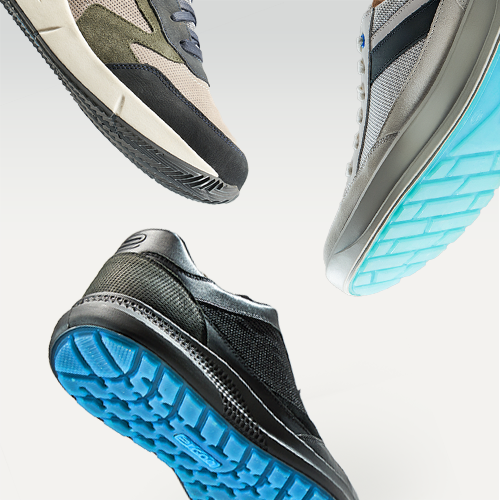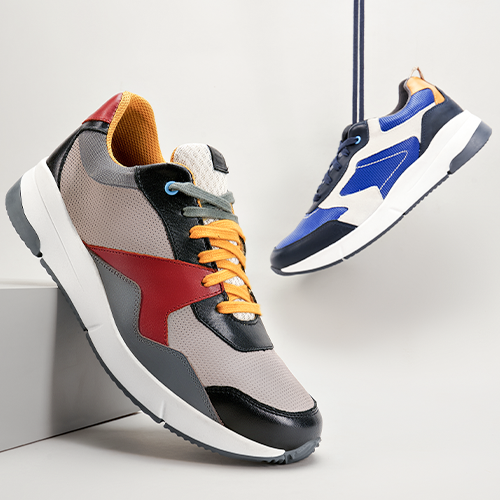Detailed Guide on Various Shoe Sole Types


Shoes or clothing, we all want something that is comfortable and makes our day manageable. Now, imagine walking in the most uncomfortable pair of shoes you've ever worn for the entire day. You might be able to do it, but you'll have leg cramps the next day.
It is important to get the perfect shoe type as well as the shoe sole. For the shoe sole, footwear manufacturers have a wide selection of materials to choose from. And anyone looking for a shoe should look at the durability and versatility of the sole, as it will allow them to utilise it for any activity. Natural materials such as leather, rope, cork, wood, and para are used alongside synthetic ones to manufacture a shoe sole. The flexibility of the sole is determined by the material and the various shoe sole types. And the substance of the shoe sole is significant in this regard.
Types of shoe sole material:
There are as many different varieties of shoe outsoles as shoe types, but finding the perfect one is crucial. The following are the most common shoe sole materials:
-
Leather Sole
The leather shoe sole is made of microscopic filiform strands that have been gathered into larger fibres and interlaced in a three-dimensional design. It creates a network of air tubes and tunnels. If properly maintained, leather sole shoes are one of the most durable of all the soles.
See Also: Comfortable Dress Shoes
The leather is resistant to perforation due to the unusual arrangement of the fibres. It provides good heat insulation despite the emphasised breathability. They've also been popular for a long time because of their permeability, which keeps your feet dry and allows them to mould to any foot shape.
-
Rubber Sole
Rubber soles are flexible, water-resistant, and long-lasting. They are perfect for everyday wear because they can resist daily wear and tear. Organic or repurposed rubber is used to make these soles.
From formal shoes to hiking boots, they can be customised to fit a variety of shoe styles. The thick shoe sole gives a more casual appearance and is sometimes prone to cracking when prolonged wear.
-
Combination Sole
As the name implies, combination soles are made from both leather and rubber shoe sole types. In other words, while the entire sole is composed of leather, the forepart and heel are covered in rubber.
They are highly durable and provide more traction as the heel is constructed of rubber. They're most commonly found on dress boots, where they combine durability and formality with extra traction. They are one of the safest types of shoe sole material.
-
Cork Sole
Cork soles are made from a soft material obtained from cork trees and a rubber mixture. They also provide excellent impact resistance and foot support, making them suitable for long usage periods.
They are also waterproof and slip-resistant; as a result, they have a lot of traction. They are light and appear to be thin. But the absence of lines and lugs makes them unsuitable for winters.
-
Polyurethane sole
Polyurethane shoe soles are long-lasting, comfortable, and waterproof. They are available in two forms:
- Thermoplastic polyurethane: sports, work boots, and leisure shoes
- Two-component polyurethane: isocyanate and polyol (accessible in liquid form)
Many people prefer them because of their low density, good slip resistance, excellent shock absorption, and wear resistance qualities.
-
PVC sole
PVC (polyvinyl chloride) is one of the most widely used plastics globally and is known for its insulation properties. Because of technological development, it has achieved a good level of environmental and application efficiency, allowing it to guarantee maximum safety in accordance with all the stages.
Because of shock absorption and added support, you can stand all day long in these shoe soles without feeling uncomfortable or having any leg cramps.
-
EVA sole
EVA is a polymer mostly made up of ethylene and vinyl acetate. It is primarily used in the manufacturing of soles and midsoles. They are exceedingly light, have excellent flexibility and elasticity, and are extremely durable.
They provide the best shock absorption and are used by most brands. The lightness, flexibility, and elasticity of the microporous soles come with the ability to retain their original shape and fit.
-
TPR sole
TPR outsoles are compounds whose fundamental component is styrene-butadiene-styrene (SBS) coupled with oils, polystyrene, mineral fillers, colours, and antioxidants. They are suited for both applied and direct injection into the shoe. Rubber granules and solid raw materials are moulded and combined into thermoplastic rubber.
If properly designed, thermoplastic rubbers have no problem with cold resistance and can maintain excellent elasticity at extremely cool temperatures. The advantages of these soles are that they provide excellent slip resistance and shock absorption but are not the best option if you want something to wear for long hours.
-
BPU sole
TPR outsoles are compounds whose fundamental component is styrene-butadiene-styrene (SBS) coupled with oils, polystyrene, mineral fillers, colours, and antioxidants. They are suited for both applied and direct injection into the shoe. Rubber granules and solid raw materials are moulded and combined into thermoplastic rubber.
If properly designed, thermoplastic rubbers have no problem with cold resistance and can maintain excellent elasticity at extremely cool temperatures. The advantages of these soles are that they provide excellent slip resistance and shock absorption but are not the best option if you want something to wear for long hours.
Which sole is the best for shoes?
Rubber shoes sole types are the best since they are water-resistant, rugged and can be used as work shoes, hiking shoes, and winter boots.
They are incredible for everyday use and fit comfortably. Rubber shoe soles can even get customised to different shoe styles. If you are looking for something that you want to wear every day, then rubber footwear is the best choice as it can resist daily wear and tear.
Conclusion
The sole is made up of various materials, and it tells a lot about the whole shoe’s processing and finishing. Hence, it’s crucial to make a remarkable decision.
Check out the Ergon’s outsoles which are best in comfort, resistance, and durability. The Injection Moulding Technique makes the sole injected to the upper part and thus ends up as the best fit that can be used for various purposes.


